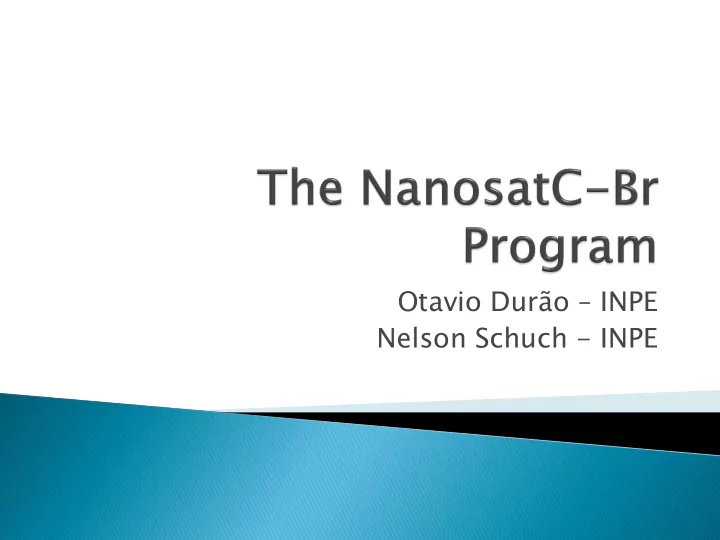

Otavio Durão – INPE Nelson Schuch - INPE
Launch in 06/19/14 Still working
Started with an undergraduate student and a research initiation schoolarship – Federal University of Santa Maria in 2008. In 2009 decision to launch it! To prove that cubesats can work ◦ Purchase the subsystems from ISIS ◦ Payload development, AIT, launch and operation ◦ Two ground stations operated by students
6 payloads On board software Purchased 2U platform Increase the number of partners Launch by mid 2018
To develop the platform subsystems ◦ In partnership with brazilian industries ◦ Not necessarily from the space sector ◦ Funded through R&D State Funding Agency – FAPESP Through the private sector – “prime contractor ” Mission is scientific – X ray measurements (INPE)
New and more complex missions Up grade in reliability International cooperation Mission SPORT ◦ Scintillation Prediction Observations Research Tasks ◦ Ionospheric Science/Application Mission ◦ 6U cubesat ◦ Cooperation with NASA, Air Force Institute of Technology (Brasil) and american universities.
Measurements to uderstand the formation of ionospheric plasma bubbles ◦ Signal interference in this region ◦ GPS outage and precision. ◦ Ecquatorial region. Work distribution ◦ NASA and american universities – 5 payloads ◦ ITA – 6U plataform ◦ INPE – ground operation, AIT and data distribution
Call for proposal at NASA ◦ Winning among 70 proposals (3 selected) ◦ Heliospheric Division Brazilian part granted by FAPESP – R&D Funding State Agency ◦ Also very competitive and lenghty process Launch provided by NASA from the ISS ◦ Launch scheduled for Oct. 19 ◦ Expected nominal life – 1 year NASA (Marshall and Goddard), ITA, INPE, Utah State University, University of Texas Dallas, Aerospace Corporation and University of Alabama Huntsville.
AESP-14 – launched from the ISS in Jan. 15 ◦ ITA ◦ 1U SERPENS – 3U; launched from ISS in Sept. 15 ◦ University of Brasilia ITASAT – 6U; ITA; delivered to launch PSLV Others under development ◦ CONASAT ◦ SERPENS 2 and 3 ◦ Lightning detector – 3U ◦ INPE Graduate School cubesat
NanosatC-Br1 a pathfinder for cubesat missions in Brasil Change in perspective since then, even at INPE and AEB (Brazilian Space Agency) Seems to be consolidated in terms to explore the possibilities Highly motivational in general (young and not so young professionals and students) Budget feasibility
To organize it under a national program (?) Increase reliability; R&D work Private projects and applications Move from public to private.
Recommend
More recommend